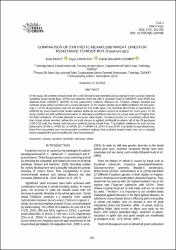| dc.contributor.author | Başer, İsmet | |
| dc.contributor.author | Çay, Feyza Tahan | |
| dc.contributor.author | Göçmen, Damla Balaban | |
| dc.date.accessioned | 2023-05-06T17:23:42Z | |
| dc.date.available | 2023-05-06T17:23:42Z | |
| dc.date.issued | 2022 | |
| dc.identifier.issn | 1301-1111 | |
| dc.identifier.uri | https://doi.org/10.17557/tjfc.1187496 | |
| dc.identifier.uri | https://hdl.handle.net/20.500.11776/12254 | |
| dc.description.abstract | In the study, 58 synthetic bread wheat lines and 6 bread wheat varieties used as standard were used as material. Synthetic bread wheat lines: ZFSN was obtained from the elite 2 synthetic lines of CIMMYT and HRSN was obtained from CIMMYT 14SYNT. In the experiment, Selimiye, Flamura 85, Pehlivan, Aldane, Bereket and Gelibolu bread wheat varieties were used as standard. In the studies carried out in field conditions for two years, only 11 of the 64 genotypes had root rot above the 2.00 scale value. The fact that all of these 11 genotypes are different by years reveals that studies without artificial inoculation should be repeated for more years. In the study carried out with artificial inoculation in laboratory conditions, the root rot values were much higher than the field conditions. The data obtained in two years show higher resistance to root rot of synthetic wheat lines than bread wheat varieties. When inoculated by artificial inoculation, all of the 28 genotypes (2.00-2.33) with the lowest root rot were synthetic bread wheat lines. The highest resistance to root rot was observed in ZFSN 6, HRSN 11-14, HRSN 13-17, HRSN 6-8, ZFSN 8 and ZFSN 3 synthetic bread wheat lines. Data from studies conducted over two years indicate that synthetic bread wheat lines are valuable source material for plant breeding for root rot resistance. | en_US |
| dc.description.sponsorship | Tekirdag Namik Kemal University [NKUBAP.00.24.DRGA.13.03] | en_US |
| dc.description.sponsorship | The study was supported by Tekirdag Namik Kemal University Scientific Research Project NKUBAP.00.24.DRGA.13.03 Morphological and molecular characterization of synthetic hexaploid wheat lines and bread wheat genotypes. | en_US |
| dc.language.iso | eng | en_US |
| dc.publisher | Soc Field Crop Sci | en_US |
| dc.identifier.doi | 10.17557/tjfc.1187496 | |
| dc.rights | info:eu-repo/semantics/openAccess | en_US |
| dc.subject | Disease | en_US |
| dc.subject | sensitive | en_US |
| dc.subject | synthetic | en_US |
| dc.subject | tolerance | en_US |
| dc.subject | wheat | en_US |
| dc.subject | Mapping Resistance | en_US |
| dc.subject | Bread Wheat | en_US |
| dc.subject | L. | en_US |
| dc.title | COMPARISON OF SYNTHETIC HEXAPLOID WHEAT LINES FOR RESISTANCE TO ROOT ROT (Fusarium spp.) | en_US |
| dc.type | article | en_US |
| dc.relation.ispartof | Turkish Journal Of Field Crops | en_US |
| dc.department | Fakülteler, Ziraat Fakültesi, Tarla Bitkileri Bölümü | en_US |
| dc.identifier.volume | 27 | en_US |
| dc.identifier.issue | 2 | en_US |
| dc.identifier.startpage | 251 | en_US |
| dc.identifier.endpage | 255 | en_US |
| dc.institutionauthor | Başer, İsmet | |
| dc.institutionauthor | Göçmen, Damla Balaban | |
| dc.relation.publicationcategory | Makale - Uluslararası Hakemli Dergi - Kurum Öğretim Elemanı | en_US |
| dc.identifier.wos | WOS:000911823600001 | en_US |
| dc.identifier.scopus | 2-s2.0-85149143798 | en_US |



















